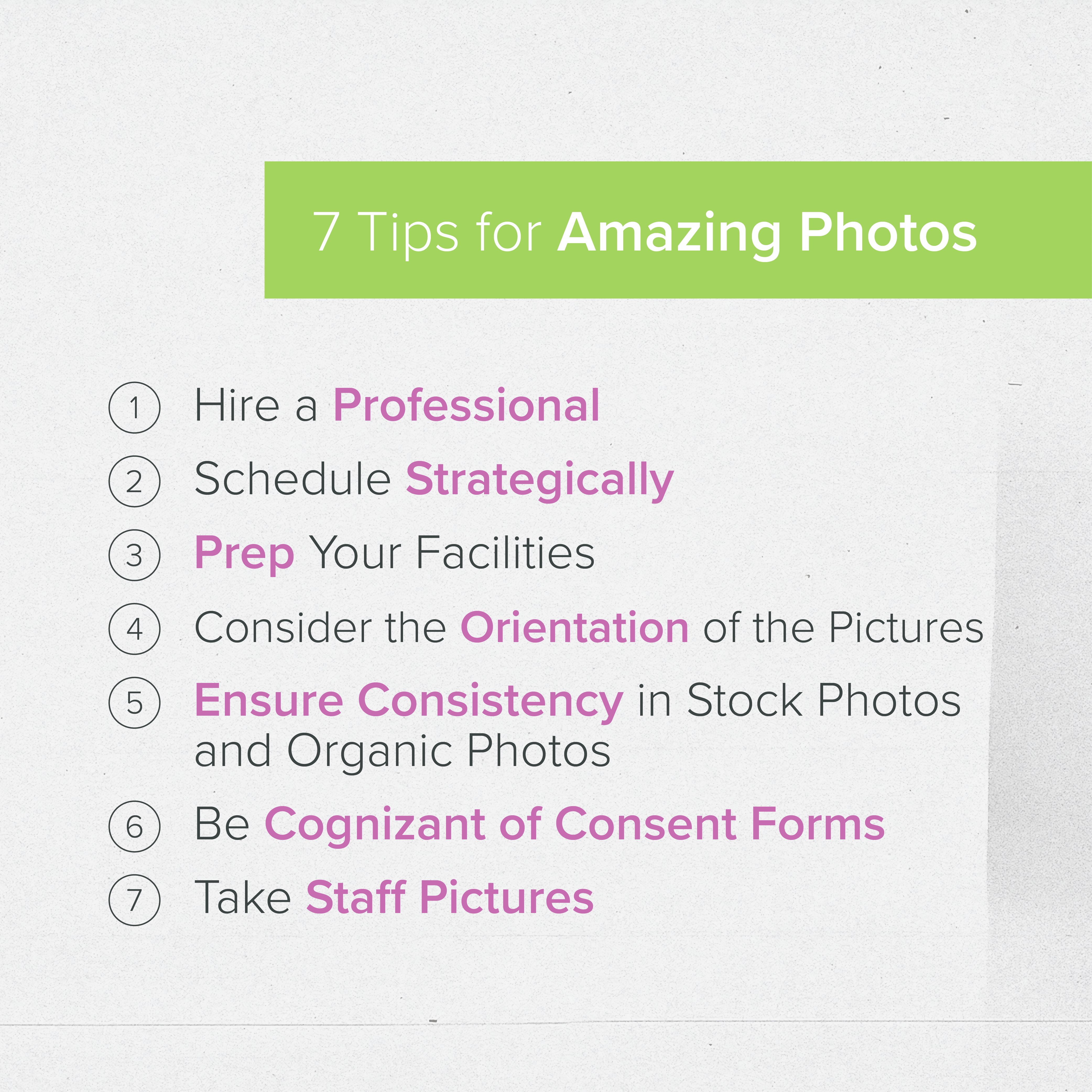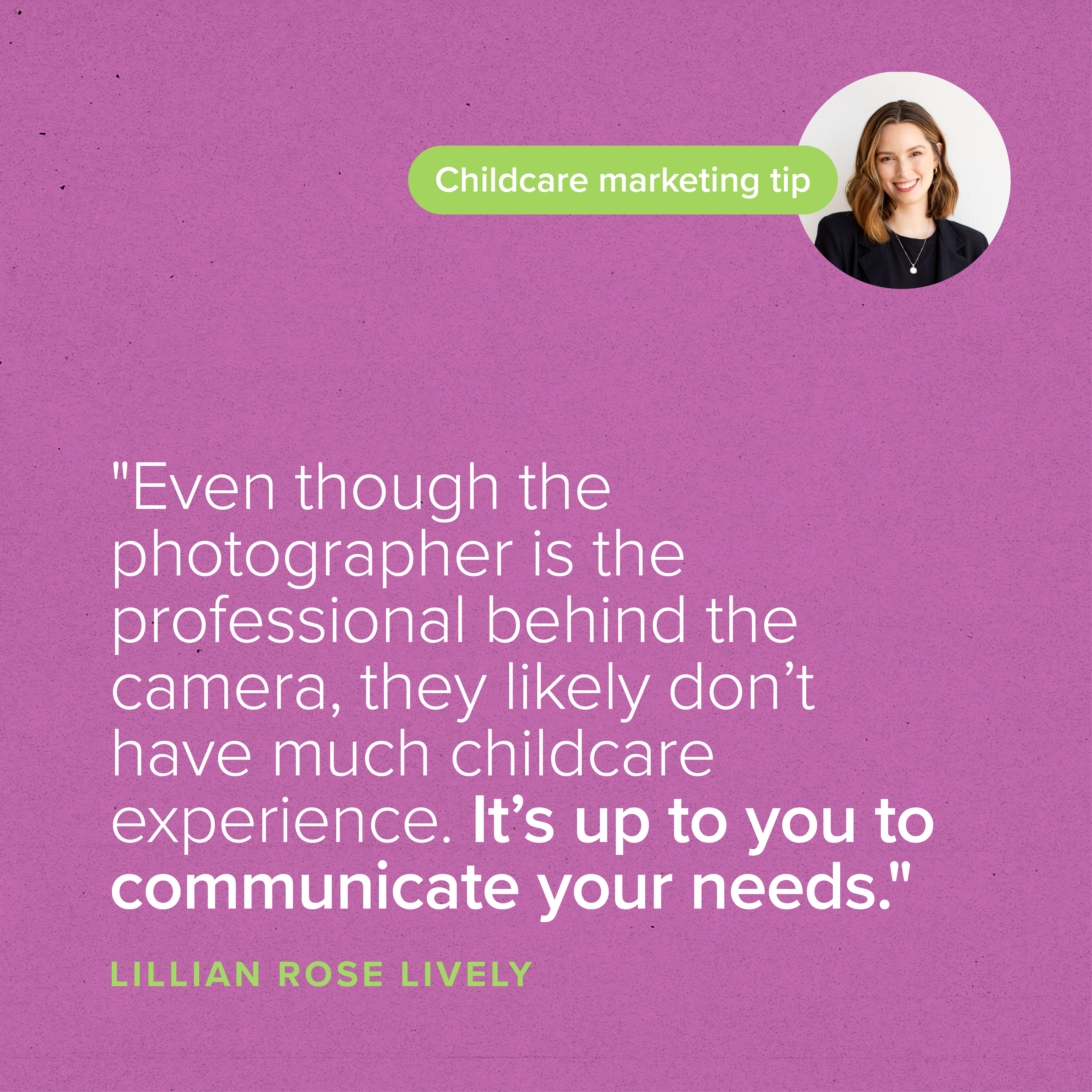It’s important to know exactly what you want to get out of your childcare center’s next photo shoot before your photographer comes in.
Photography isn’t cheap. Since you’ll probably have a set number of hours booked, efficiency is essential. It’s in everyone’s best interest to get it right the first time, so making a to-do list of priorities and knowing how much time to spend on each task can make a huge difference.
Even though the photographer is the professional behind the camera, they likely don’t have much childcare photography experience; unlike weddings and real estate, childcare isn’t an established photography niche. That means it’s up to you (and your marketing agency) to communicate what shots you need.
What Photos Should You Include?
The following images are always valuable and have many marketing uses:
- Exterior of your building
- Playgrounds
- Drop off area
- Bus and transportation (if wrapped with branding)
- Interior of your building
- Front desk
- Classrooms — with and without kids present
- Specialty rooms
- Dining room
- Art room
- STEM/STEAM room
- Activity rooms
- Any other differentiators, such as gymnastics or dance classes
- Children — happy and engaged with each other and with teachers, playing, eating, learning, interacting, etc.
- Special equipment
- Healthy, beautifully plated food
- Happy teachers and staff
- Parents and teachers interacting
- “Peace of Mind” shots — photos that reassure interested parents their child will be protected and well cared for
- Security cameras
- Key entrances
Where to Leverage Your Photos
Once you have all those fantastic photos, use them to market your school by including them on/in your:
- Website
- Social media
- Ads — digital and print
- Marketing materials — digital and print (enrollment packets)
- In-school signage and banners
- Email marketing materials
- Online listings (Google My Business, Yelp, etc.)

7 Tips and Best Practices for Amazing Photos
A successful photo shoot can take your branding to the next level. Here are some best practices that make the most of the experience.
1. Hire a Professional
There’s a massive difference between hiring a professional photographer and recruiting a student with a DSLR camera — or worse, a friend’s kid with an iPhone.
Most professionals use mirrorless cameras, which cost thousands of dollars. A DSLR camera starts at around $400; the same with an iPhone. Like most things in life, you get what you pay for.
Yes, a student or a friend’s kid will initially cost less than a professional, but you’ll often end up with unusable photos — a wasted investment.
So, trust us — invest in a professional photographer.
Also, consider the photographer’s specialty. What’s their niche?
Although childcare photographers aren’t common, you still want to look for skill overlap. Portrait photography, real estate, and senior facility photography have many beneficial similarities.
2. Schedule Strategically
Choose the time of year strategically. Avoid seasonal decorations and weather that affects the landscaping, such as dead grass in winter.
Usually, spring, early summer, and fall are good times of year to take pictures. Avoid cloudy days.
The time of day also matters. Natural light is crucial for capturing great photos. First thing in the morning is a good time, since the school will be clean. If you start early enough, you’ll be able to capture images of the facility while empty, and later, with children arriving.
Of course, you may need to schedule a photographer for two days to obtain all the necessary images. Remember, you want pictures of empty classrooms to use as stock images, but also plenty of engaging images of children, parents (if possible), and staff.
3. Prep Your Facilities
First and foremost, your school should be spotless. A professional-grade camera will capture every fingerprint on the windows and smudge on the desks. Be meticulous in your cleaning and be cognizant of this when you schedule.
Second, be mindful of how you stage rooms. For example, a cup of hot coffee on a desk doesn’t comply with licensing.
While it’s a less serious offense, broken, faded toys and books are an eyesore. Be sure to remove them from shots beforehand rather than relying on Photoshop later.
Photo editing should be part of the process, but asking your photographer to edit every image because you were lazy in your prep work is a huge, unnecessary expense. And sometimes, it’s simply not possible.
4. Consider the Orientation of the Pictures
You’ll need various formats of images depending on where and how you use them. For example, when it comes to website banners, you’ll need wide, horizontal images with lots of blank space on each side, or in thirds for text placement. The ideal dimensions might look something like 6867 × 3592.
You’ll need to communicate this to your photographer before the shoot so they can accommodate your needs and give you plenty of options.
5. Ensure Consistency in Stock Photos and Organic Photos
Even after a two-day photo shoot, you’ll inevitably still incorporate stock photos into your marketing. You’ll want those photos and the photos from your shoot to bear as strong a resemblance as possible.
To ensure this, show the stock photos you use to the photographer beforehand and request that they consider them during editing. That way, the photographer can match them in terms of lighting, atmosphere, mood, etc.
6. Be Cognizant of Consent Forms
If you don’t have a signed consent form for a child, you cannot take photos of that child. It’s essential that you make the director and staff aware of this, and they must take it very seriously.
The director or informed staff member should always accompany the photographer. It’s not the photographer’s responsibility to know which children’s parents have signed consent forms. Rather, it’s your responsibility to guide the process.
Parents may revoke permission to photograph at any time. So, be sure to photograph many different children.
7. Take Staff Pictures
Staff photos make great additions to the school website. You can take individual staff headshots, but that may be challenging since the turnover rates for these positions can be high. You can also take separate headshots of the owners and directors since these positions tend to have low turnover.
Remind everyone to look their best on photo shoot day, and have your staff wear their branded school polo or T-shirt — but count on some people forgetting.
It’s a great idea to have some extra branded shirts on hand (in different sizes) as well as some new hairbrushes and combs (we all know not to share!), hair ties, bobby pins, and other toiletries. This will help your staff feel a little less stressed and a little more loved.
How Often Should You Take Pictures?
Consider a reshoot every two to three years, or any time you do a rebrand, a major remodel, or a website update.
Plan Your Next Photo Shoot
Talk to your marketing agency and web designer to plan your next photo shoot. They can guide you through the process and provide you all the information you’ll need to forward your photographer to ensure you get the most out of your investment.
We do this for our clients often and save a ton of time and money by being proactive on the front end.
If you don’t have a marketing partner yet and want to know how we can help you, schedule a discovery call. We’d love to explore how we can partner together to optimize your business.

Subscribe
Sign up with your email address to receive news and updates.

